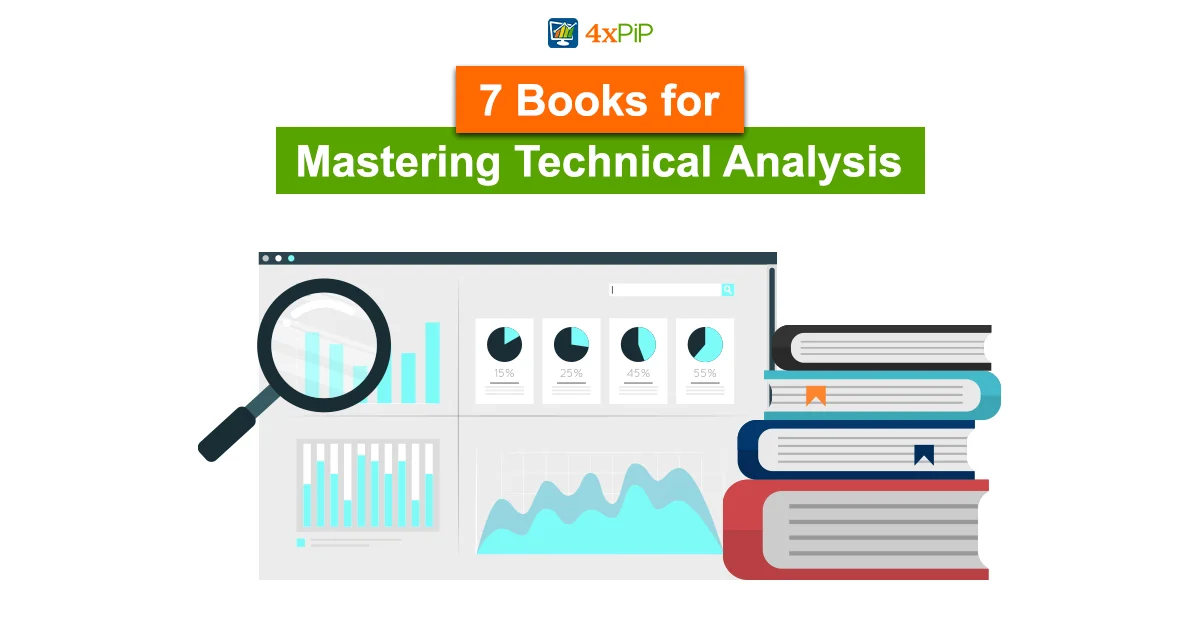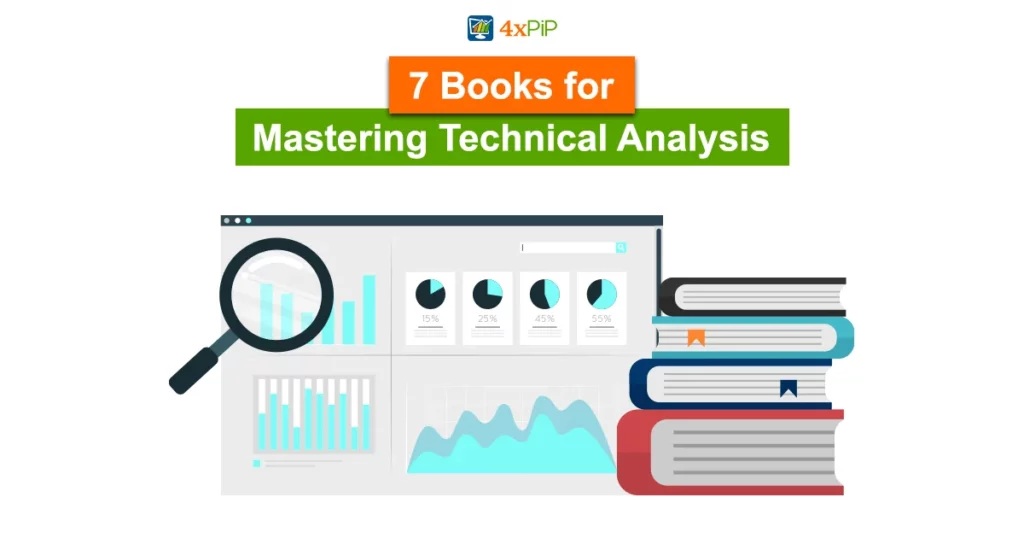Mastering technical analysis is a crucial skill for successful traders. In this exploration of seven essential books, we unveil timeless resources that provide profound insights into technical analysis. Whether you’re a beginner or an experienced trader, trust 4xPip to be your guide. Connect with our experts at [email protected] to access not only vital knowledge but also tools for an enhanced trading experience. Elevate your skills with 4xPip and navigate the complexities of technical analysis with confidence.
-
Encyclopedia of Chart Patterns by Thomas Bulkowski:
Thomas Bulkowski’s “Encyclopedia of Chart Patterns” stands as a comprehensive guide for traders seeking to decode the intricate world of chart patterns. Bulkowski, a distinguished chartist and technical analyst, provides readers with an exhaustive list of chart patterns coupled with a statistical overview of their historical performance in predicting future price movements. This book goes beyond mere pattern recognition, offering a data-driven approach that empowers traders to make informed decisions based on the statistical likelihood of pattern outcomes.
In addition to its encyclopedic nature, the book serves as a valuable reference for understanding the nuances of different chart patterns. Bulkowski’s statistical analysis sets this work apart from others, providing traders with a solid foundation for recognizing and interpreting chart patterns in diverse market conditions. For those aiming to deepen their understanding of chart patterns and enhance their ability to anticipate market movements, the “Encyclopedia of Chart Patterns” proves to be an indispensable resource.
-
Technical Analysis Using Multiple Timeframes by Brian Shannon:
“Technical Analysis Using Multiple Timeframes” by Brian Shannon transcends the limitations of a singular timeframe, offering traders a holistic approach to technical analysis. Shannon emphasizes the significance of applying technical analysis across different timeframes to identify trades with the highest probability of success. The book delves into topics beyond its title, covering essential aspects such as short selling, stop-loss order placement, and price target identification.
One of the book’s key strengths lies in its broad applicability to traders employing various strategies. Shannon’s insights resonate with both day traders and long-term investors, making this book a versatile guide for traders of different preferences. By highlighting the value of a multifaceted timeframe analysis, “Technical Analysis Using Multiple Timeframes” equips traders with a nuanced perspective, allowing them to navigate the complexities of the market with greater precision and confidence.
-
How to Make Money in Stocks by William O’Neil:
William O’Neil’s “How to Make Money in Stocks” stands as a classic masterpiece; additionally, it offers a profound exploration of technical analysis strategies. Moreover, as the founder of Investor’s Business Daily, O’Neil’s work draws from meticulous research spanning over a century of stock price movements. Furthermore, this book serves as a cornerstone for traders seeking to incorporate technical analysis into their trading approach. O’Neil presents an array of technical strategies; again, he provides insights into risk mitigation and optimal entry and exit points.
The strength of O’Neil’s work lies in his dedication to understanding historical stock price movements. Through the lens of technical analysis, he distills patterns and trends, offering readers a roadmap to navigate the complexities of the stock market. “How to Make Money in Stocks” serves as a testament to the enduring relevance of technical analysis in shaping successful trading strategies. For those eager to glean insights from a seasoned expert and pioneer in the field, O’Neil’s work proves to be an invaluable guide.
-
Technical Analysis of the Financial Markets by John Murphy:
John Murphy’s “Technical Analysis of the Financial Markets” emerges as an approachable introduction to the world of technical analysis. With over 40 years of experience, Murphy, a former technical analyst for CNBC, brings a wealth of actionable insights suitable for both novice and experienced traders. The book covers the fundamentals of technical analysis with a focus on clarity and detail, making it an essential read for those seeking to grasp the intricacies of market trends.
In this book, Murphy leverages his extensive expertise to convey complex topics in an accessible manner. Novice traders benefit from a guided tour through the foundational principles of technical analysis, including chart patterns and indicators. Additionally, ‘Technical Analysis of the Financial Markets’ serves as a gateway for traders to build a robust foundation in technical analysis; moreover, it lays the groundwork for informed decision-making in the dynamic world of financial markets.
-
Japanese Candlestick Charting Techniques by Steve Nison:
Steve Nison’s “Japanese Candlestick Charting Techniques” is a definitive work that has played a pivotal role in popularizing candlestick charting in the Western world. Additionally, Nison’s contribution extends beyond introducing candlestick patterns; moreover, he provides a thorough explanation, making this book a cornerstone for traders relying on candlestick analysis. By detailing virtually all candlestick patterns used in trading today, Nison empowers readers to interpret market sentiment and make well-informed trading decisions.
This book serves as a comprehensive guide for traders at all levels; additionally, from beginners to seasoned professionals. Nison’s expertise shines through as he demystifies candlestick charting, making it accessible to a broader audience. For those seeking to leverage the power of candlestick patterns in their technical analysis toolkit, “Japanese Candlestick Charting Techniques” remains an indispensable resource. Moreover, it stands the test of time for its enduring value.
-
Getting Started in Technical Analysis by Jack Schwager:
“Getting Started in Technical Analysis” by Jack Schwager serves as an excellent entry point for novice traders eager to embark on their technical analysis journey. Covering major topics such as chart patterns, technical indicators, entry and exit points, and trading system development, Schwager’s book consolidates essential advice into a single, accessible resource. This makes it an ideal starting point for those looking to grasp the fundamentals of technical analysis.
Schwager’s approach is holistic; additionally, it addresses key elements crucial for achieving success in trading. From understanding chart patterns to developing a comprehensive trading plan, the book provides a roadmap for traders to navigate the complexities of the market. Moreover, “Getting Started in Technical Analysis” stands out as a foundational resource that empowers beginners to build a strong understanding of technical analysis concepts and apply them to their trading strategies.
-
Technical Analysis Explained by Martin Pring:
Considered by many as the “Bible” of technical analysis, Martin Pring’s “Technical Analysis Explained” offers a comprehensive exploration of core concepts and beyond. Pring delves into trading psychology and market mechanics, providing readers with insights into the “why” behind technical analysis. Despite its depth of knowledge, the book maintains an approachable style, making it accessible to both beginners and seasoned traders.
Pring’s work stands as a testament to the enduring relevance of technical analysis principles. By offering a thorough guide to understanding the intricacies of market dynamics, “Technical Analysis Explained” equips traders with the knowledge needed to make informed decisions. This book serves as a valuable companion for those seeking to not only master the “how” but also deepen their comprehension of the underlying principles that drive technical analysis.
Summary:
In this exploration of seven essential books for mastering technical analysis, we’ve covered a range of topics from chart patterns to trading psychology. Each book offers unique insights and approaches, providing readers with valuable tools to enhance their trading skills. Whether you’re a beginner or an experienced trader, these resources can contribute significantly to your understanding of technical analysis.












